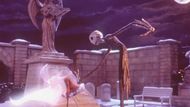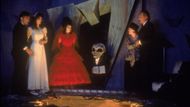The journey of The Nightmare Before Christmas as the blueprint for goth culture in the mainstream extends far beyond Halloween nostalgia, examining how a singular film reshaped attitudes, aesthetics, and identities across decades. Born from a 1982 Tim Burton poem and brought to life as a 1993 Disney release under the Touchstone banner, the film presents Jack Skellington, Halloween Town’s restless Pumpkin King, discovering Christmas and grappling with belonging and creative dissatisfaction.
Its pioneering use of stop-motion animation and Elfman’s macabre melodies provided an anchor for fans drawn to gothic visuals and outsider narratives. In the years since its premiere, the film’s shadow-soaked mise-en-scène, lyrical exploration of otherness, and merchandise ubiquity have inspired goth fashion, rock imagery, and a DIY ethos that continues to ripple through alternative subcultures.
The Nightmare Before Christmas is the blueprint for goth culture
The Nightmare Before Christmas blends macabre imagery with approachable narrative, from the opening titles, which feature skeleton figures dancing in moonlight, to Jack Skellington's spritely silhouette against the spiral slope. The story, which is set in Halloween Town and is populated by night animals, centers on Jack's exploration to Christmas Town and his foolish effort to combine the two celebrations.
Fans looking for representation of their own dualities found resonance in the tonal combination of beauty and horror created by this collision of macabre and festive themes, which is emphasized by Danny Elfman's lyrical music and songs like "This Is Halloween" and "What's This?".
The movie drew on gothic traditions: romanticism, chiaroscuro, and fixation with death, to create a world where monsters sing carols and skeletons carve pumpkins, all the while evoking sympathy for marginalized individuals. Jack is the quintessential outsider: articulate, aspirational, and seeking meaning. While Sally's patched face and subdued color scheme serve as inspiration for DIY fashion projects and cosmetic styles, his striped suit and pin-headed bow tie have come to be synonymous with gothic fashion.
Here’s a glimpse of the character who started it all:

Beyond visuals, the film’s thematic core—embracing one’s uniqueness and challenging conventions—echoes the goth mantra of authenticity over assimilation. By blending horror motifs with heart, it forged an aesthetic blueprint: heavy contrast, ornate silhouettes, and a celebration of the uncanny. These elements provided a template for goth subculture to flourish, influencing everything from concert stage sets to streetwear collaborations and fueling a generation’s embrace of dark glamor.
Expanding the gothic legacy: Fans, merch, and kindred films
Fan communities and rituals
Since its release, The Nightmare Before Christmas has inspired grassroots fan communities that celebrate and reinterpret its gothic vision. Annual Halloween screenings and midnight showings draw crowds dressed as Jack, Sally, Oogie Boogie, and other residents of Halloween Town, transforming local theaters into immersive realms of dark fantasy.
Online forums and social-media groups exchange DIY tutorials for Jack-inspired makeup, replica props, and stop-motion-style crafts, sustaining enthusiasm well beyond the film’s theatrical runs.
The Nightmare Before Christmas' merchandising and the Hot Topic phenomenon
Key to The Nightmare Before Christmas' mainstream goth status was its early partnership with alternative retailer Hot Topic. In 1994, the chain began stocking Jack Skellington T-shirts, accessories, and collectibles—sales that reportedly exceeded projections tenfold in its inaugural year.
Hot Topic’s dimly lit aisles and counterculture branding provided a natural home for Nightmare merchandise, making gothic motifs accessible to teens nationwide. Over the decades, collaborations expanded into eyeshadow palettes, glow-in-the-dark hoodies, LEGO sets, and limited-edition vinyl figures, cementing the film’s iconography in retail culture.
Musical and aesthetic cross-pollination
The Nightmare Before Christmas influence permeated goth, punk, and metal scenes, where bands adopted its stark imagery for album art, stage backdrops, and tour visuals. Artists cite Jack Skellington as a symbol of outsider resilience, while Elfman’s score inspired a wave of symphonic gothic compositions.
We can also note how rock fans embraced the film’s “spooky misrule,” finding in its characters icons of misunderstood creativity and rebellion against the mainstream’s bright, saccharine norms. Concert merch featuring Jack’s skull face and twisted hill silhouettes became staples at shows, blurring lines between film fandom and music subculture.
Other genre-defining films
While The Nightmare Before Christmas stands as a seminal work, it joined a lineage of movies shaping goth aesthetics: Tim Burton’s Beetlejuice (1988) with Winona Ryder’s Lydia Deetz declaring “I myself am strange and unusual,” and The Addams Family (1991), whose macabre humor and moody color palettes reinforced goth style tropes.

Later, stop-motion films like Coraline (2009) and Corpse Bride (2005) built on Burton’s visual language, introducing new generations to gothic fantasy and maintaining the genre’s vitality. Each contributed layers to the blueprint, whether through skeletal design motifs or themes of misfit solidarity, that continue to inform goth culture today.
The YouTube deep dive and academic interest
Documentaries and retrospectives, such as the YouTube deep dive “The Troubled History of The Nightmare Before Christmas,” examine the film’s development challenges, Burton’s creative vision, and Disney’s initial reservations about its dark tone. Academic articles and film studies courses reference it as a case study in how animation can articulate subcultural identities, further legitimizing goth culture within scholarly discourse.
Over thirty years on, The Nightmare Before Christmas endures as more than a Halloween staple: it’s a cultural lodestone for goth aesthetics, demonstrating how dark whimsy and empathetic storytelling can resonate across generations. By combining innovative stop-motion artistry, Elfman’s evocative score, and characters who embody the outsider’s quest for belonging, the film offered fans a visual and emotional lexicon that fueled goth fashion, music, and fan rituals.
Its pioneering merchandising partnerships—most notably with Hot Topic—ensured that Jack Skellington’s pinstripe suit and skeletal grin remained in the public eye, influencing everything from runway trends to indie-band album art.
As both a cinematic work and a counter-culture manifesto, The Nightmare Before Christmas exemplifies how movies can spawn enduring subcultures. Its legacy lives on in Halloween streetwear, midnight screenings, and the generations who paint their nails black and carve pumpkins shaped like a grinning skull. In the ongoing dialogue between art and identity, this 1993 classic remains the blueprint by which gothic charm seeped into the mainstream, proving that even the spookiest tales can illuminate the human longing for community and self-expression.
Love movies? Try our Box Office Game and Movie Grid Game to test your film knowledge and have some fun!
